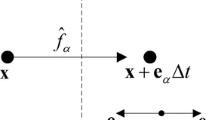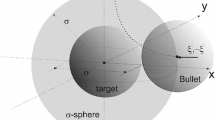Abstract
In this paper, we focus on the nonlinear coupling mechanism of the Nernst–Planck model and propose a coupled lattice Boltzmann method (LBM) to solve it. In this method, a new LBM for the Nernst–Planck equation is developed, a multi-relaxation-time (MRT)-LBM for flow field and an LBM for the Poisson equation are used. And then, we discuss the choice of the model and found that the MRT-LBM is much more stable and accurate than the LBGK model. A reasonable iterative sequence and evolution number for each LBM are proposed by considering the properties of the coupled LBM. The accuracy and stability of the presented coupled LBM are also discussed through simulating electro-osmotic flows (EOF) in micro-channels. Furthermore, to test the applicability of it, the EOF with non-uniform surface potential in micro-channels based on the Nernst–Planck model is simulated. And we investigate the effects of non-uniform surface potential on the pattern of the EOF at different external applied electric fields. Finally, a comparison of the difference between the Nernst–Planck model and the Poisson–Boltzmann model is presented.









Similar content being viewed by others
References
Gad-el-Hak, M.: The MEMS Handbook. CRC Press, Boca Raton, FL (2002)
Stone, H.A., Stroock, A.D., Ajdari, A.: Engineering flows in small devices: microfluidics toward a lab-on-a-chip. Annu. Rev. Fluid Mech. 36, 381–411 (2004)
Chai, Z.H., Shi, B.C.: Simulation of electro-osmotic flow in microchannel with lattice Boltzmann method. Phys. Lett. A 364, 183–188 (2007)
Chai, Z.H., Shi, B.C., Zheng, L.: Lattice Boltzmann simulation of viscous dissipation in electro-osmotic flow in microchannels. Int. J. Mod. Phys. C 18(7), 1119–1131 (2007)
Fu, L.M., Lin, J.Y., Yang, R.J.: Analysis of electroosmotic flow with step change in zeta potential. J. Colloid Interface Sci. 258(2), 266–275 (2003)
Park, H.M., Lee, J.S., Kim, T.W.: Comparison of the Nernst-Planck model and the Poisson-Boltzmann model for electroosmotic flows in microchannels. J. Colloid Interface Sci. 315(2), 731–739 (2007)
Bhattacharyya, S., Nayak, A.K.: Electroosmotic flow in micro/nanochannels with surface potential heterogeneity: An analysis through the Nernst-Planck model with convection effect. Colloid Surf. A 339(1–3), 167–177 (2009)
Yang, R.J., Fu, L.M., Hwang, C.C.: Electro-osmotic entry flow in a microchannel. J. Colloid Interface Sci. 224(1), 173–179 (2001)
Ng, E.Y.K., Tan, S.T.: Study of EDL effect on 3-D developing flow in microchannel with Poisson-Boltzmann and Nernst-Planck models. Int. J. Numer. Methods Eng. 71(7), 818–836 (2007)
Chen, Z.: Comparison of the mobile charge distribution models in mixed ionic-electronic conductors. J. Electrochem. Soc. 151(10), A1576–A1583 (2004)
Benzi, R., Succi, S., Vergassola, M.: The lattice Boltzmann equation: theory and applications. Phys. Rep. 222, 145–197 (1992)
Aidun, C.K., Clausen, J.R.: Lattice Boltzmann method for complex flows. Annu. Rev. Fluid Mech. 42, 439–472 (2010)
Melchionna, S., Succi, S.: Electrorheology in nanopores via lattice Boltzmann simulation. J. Chem. Phys. 120(9), 4492–4497 (2004)
Hlushkou, D., Kandhai, D., Tallarek, U.: Coupled lattice-Boltzmann and finite-difference simulation of electroosmosis in microfluidic channels. Int. J. Numer. Methods Fluids 46(5), 507–532 (2004)
He, X., Li, N.: Lattice Boltzmann simulation of electrochemical systems. Comput. Phys. Commun. 129(1–3), 158–166 (2000)
Wang, M.R., Kang, Q.J.: Modeling electrokinetic flows in microchannels using coupled lattice Boltzmann methods. J. Comput. Phys. 229(3), 728–744 (2010)
Qian, Y.H., d’Humiéres, D., Lallemand, P.: Lattice BGK model for Navier-Stokes equations. Europhys. Lett. 17(6), 479–484 (1992)
Lallemand, P., Luo, L.S.: Theory of the Lattice Boltzmann method: dispersion, dissipation, isotropy, Galilean invariance, and stability. Phys. Rev. E 61(6), 6546 (2000)
Guo, Z.L., Zheng, C.G., Shi, B.C.: Lattice Boltzmann equation with multiple effective relaxation times for gaseous microscale flow. Phys. Rev. E 77(3), 036707 (2008)
Du, R., Shi, B.C., Chen, X.W.: Multi-relaxation-time lattice Boltzmann model for incompressible flow. Phys. Lett. A 359(6), 564–572 (2006)
Guo, Z.L., Zheng, C.G., Shi, B.C.: Discrete lattice effects on the forcing term in the lattice Boltzmann method. Phys. Rev. E 65(4), 046308 (2002)
Chai, Z.H., Shi, B.C.: A novel lattice Boltzmann model for the Poisson equation. Appl. Math. Model. 32(10), 2050–2058 (2008)
Shi, B.C., Guo, Z.L.: Lattice Boltzmann model for nonlinear convection–diffusion equations. Phys. Rev. E 79(1), 016701 (2009)
Shi, B.C., Deng, B., Du, R., Chen, X.W.: A new scheme for source term in LBGK model for convection–diffusion equation. Comput. Math. Appl. 55(7), 1568–1575 (2008)
Guo, Z.L., Zheng, C.G., Shi, B.C.: Non-equilibrium extrapolation method for velocity and pressure boundary conditions in the lattice Boltzmann method. Chin. Phys. 11(4), 366 (2002)
Tian, F., Li, B., Kwok, D.Y.: Lattice Boltzmann Simulation of Electroosmotic Flows in Micro- and Nanochannels. International Conference on MEMS, NANO, and Smart Systems (ICMENS) of 2004, Banff, Alberta, Canada, 294 (2004)
Miller, W., Succi, S.: A lattice Boltzmann model for anisotropic crystal growth from melt. J. Stat. Phys. 107(1–2), 173–186 (2002)
Acknowledgments
We gratefully acknowledge the Prof. Jiankang Wu for his helpful discussions during this work. This work is supported by the National Science Foundation of China (Grant Nos. 51125024, 51006040, 11272132) and China Postdoctoral Science Foundation (Grant No. 2012M521424).
Author information
Authors and Affiliations
Corresponding author
Rights and permissions
About this article
Cite this article
Yang, X., Shi, B., Chai, Z. et al. A Coupled Lattice Boltzmann Method to Solve Nernst–Planck Model for Simulating Electro-osmotic Flows. J Sci Comput 61, 222–238 (2014). https://doi.org/10.1007/s10915-014-9820-6
Received:
Revised:
Accepted:
Published:
Issue Date:
DOI: https://doi.org/10.1007/s10915-014-9820-6




